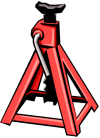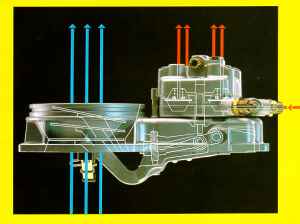



Bosch K-Jetronic Fuel Injection Part 1

The Engine's Fuel Requirements
A spark-ignition engine needs a particular
air-fuel ratio in order to operate. The ideal air-fuel ratio is 14.7:1. Certain
operating conditions make it necessary to correct the mixture accordingly.
The air-fuel ratio
Essentially, the power, the fuel consumption and
the exhaust-gas composition of a spark-ignition engine depend upon the air-fuel
ratio. Perfect ignition and perfect combustion only take place within
particular air-fuel ratios. In the case of gasoline (petrol), the ideal
air-fuel ratio is about 15:1. In other words, 15 kg of air are required for
complete combustion of 1 kg of gasoline (stoichiometric ratio). Deviations from
this ratio affect engine operation. The amount of fuel to be injected depends
upon load, engine speed and the particular exhaust-gas regulations in force at
the time. Depending upon the mode of operation, i.e. idle, part load or full
load, a different air-fuel ratio is optimal in each case. Of decisive
importance is the strict adherence to the particular most favourable air-fuel
ratio at any one time.
The excess-air factor
The excess-air factor is identified by the symbol
for Lambda.
Lambda = amount of air supplied ÷ theoretical air requirement
Lambda=1
This means that the amount of air supplied to the engine corresponds to the theoretical amount of air required (stoichiometric air-fuel ratio).
Lambda<1
This means air deficiency, or a rich mixture, and increased power.
Lambda>1
This means air excess, or lean mixture, lower fuel consumption, less power.
Lambda> 1.3
This means that the mixture will no longer ignite, the lean misfire limit (LML) has been exceeded.
Fuel-management systems
Fuel-management systems, whether of the
carburettor or injection types, have the task of preparing an optimum air-fuel
mixture. Fuel management by means of manifold injection permits the optimum
adaptation of the air-fuel mixture to every operating phase of the engine. It
also ensures a lower level of pollutants in the exhaust gas.
In spark-ignition systems, fuel management is by means of either a carburettor or a fuel-injection system. Although, up to now, the carburettor has been the most commonly used method, there has been a distinct trend in the last couple of years towards manifold fuel injection. This trend came about due to the advantages offered by fuel injection as regards the demands for fuel economy, high performance and, last but not least, a lower level of pollutants in the exhaust gas. These advantages are based on the fact that manifold fuel injection permits extremely precise metering of the fuel depending upon the operating conditions of the engine and its load, and taking environmental effects into account. With manifold fuel injection, the correct air-fuel ratio is maintained so precisely that the pollutant level in the exhaust gas is considerably lower. Since with this system, the carburettor is no longer required, the intake paths can be optimally designed and laid out. This results in better cylinder charge which in turn leads to a more favourable torque characteristic.
What types of mixture formation are available using fuel injection?
There are both mechanically and electronically controlled systems available. The K-Jetronic is a mechanical fuel injection system which injects continuously and which needs no form of drive whatsoever.
Electronically controlled systems
The fuel is supplied by an electrically driven fuel pump which develops the pressure necessary for injection. The fuel is injected by solenoid-operated fuel-injection valves into the cylinder intake ports. The injection valves are controlled by an electronic control unit (ECU) and the amount of fuel injected depends upon the length of time that they stay open. By means of sensors, the ECU is provided with information about the operating conditions of the engine and about the ambient conditions around the vehicle. The basis for assessing the amount of fuel to be injected is the amount of air drawn in by the engine. The L-Jetronic is an electronically controlled fuel-injection system. In the case of the L-Jetronic, the amount of air drawn in by the engine is directly measured by an air-flow sensor. Electronically controlled fuel-injection systems are dealt with in detail in the Publication "Electronically Controlled Fuel Injection" in the Bosch Technical Instruction series.
Mechanical systems
With mechanical fuel-injection systems, one differentiates between those which require a drive from the engine and those which do not. The engine-driven systems comprise a fuel-injection pump with an integrated governor. Their principle of operation is the same as that of the fuel-injection systems for Diesel engines. The other variation of the mechanical system is one which needs no drive and which injects continuously. This system, the K-Jetronic, is described in the following.
The K-Jetronic
The K-Jetronic is a mechanical fuel injection system from Bosch. It is divided into three main functional areas:
- Air-flow measurement
- Fuel supply
- Fuel induction
Air-flow measurement
The amount of air sucked in by the engine is controlled by a throttle valve and measured by an air-flow sensor.
Fuel supply
An electrically driven fuel pump delivers the fuel to the fuel distributor via a fuel accumulator and a filter. The fuel distributor allocates this fuel to the injection valves in the cylinder intake tubes.
Fuel induction
The amount of air, corresponding to the position of the throttle plate, sucked in by the engine serves as the criteria for the metering of the fuel to the individual cylinders. The amount of air sucked in by the engine is measured by the air-flow sensor which, in turn, controls the fuel distributor. The air-f low sensor and the fuel distributor are assemblies which form Part of the mixture control unit. Injection takes place continuously, that is, without regard to the position of the intake valve. During the intake-valve closed phase, the fuel is "stored" in the intake tubes.
Fuel supply
Outline of system
The fuel is drawn out of the fuel thank by an
electrically driven fuel pump. It is then forced, under pressure, through a
pressure accumulator and a fine filter to the fuel distributor, which is
located in the mixture control unit. The pressure is held constant by a
pressure regulator in the mixture control unit from where it flows to the
fuel-injection valves. The injection valves inject fuel continuously into the
intake ports of the engine cylinders. The designation K-Jetronic stems from his
fact ("K" stands for the German word for "continuous"). When the intake valves
open, the air-fuel mixture is drawn into the cylinders. The individual
subassemblies of the fuel-supply system are described in the following
Electric fuel pump
The electric fuel pump is a roller-cell pump the
electric motor of which is permanently surrounded by fuel. The fuel pump is
driven by a permanent magnet electric motor. The rotor disc which is
eccentrically mounted in the pump housing is fitted with metal rollers in
notches around its circumference which are pressed against the thrust ring of
the pump housing by centrifugal force and act as seals. The fuel is carried in
the cavities, which form between the rollers. The fuel flows directly around
the electric motor. There is no danger of explosion, however, because there is
never an ignitable mixture in the pump housing. The pump delivers more fuel
than the maximum requirement of the engine so that the pressure in the fuel
system can be maintained under all operating conditions. During starting, the
pump runs as long as the ignition key is operated. The pump continues to run
when the engine has started. A safety circuit is incorporated to stop the pump
running and fuel being delivered if the ignition is switched on but the engine
has stopped turning (for instance in the case of an accident).
Fuel accumulator
The fuel accumulator maintains the pressure in the
fuel system for a certain time after the engine has been switched off. When the
engine is running it serves to deaden the noise of the electric fuel pump.
After the engine has been switched off, the fuel accumulator maintains the
pressure in the fuel system in order to facilitate re-starting, particularly
when the engine is hot. The design of the accumulator housing is such that it
deadens the noise from the fuel pump when the engine is running. The interior
of the fuel accumulator is divided into two chambers by means of a diaphragm.
One chamber serves as the accumulator volume for the fuel, the other chamber
contains a spring. During operation the accumulator chamber is filled with
fuel. This causes the diaphragm to bend back against the force of the spring
until it is halted by the stops in the spring chamber. The diaphragm remains in
this position, which corresponds to the maximum accumulator volume, as long as
the engine is running.
Fuel filter
Due to the extremely close tolerances of various
components in the system, it is necessary to fit a special fine filter for the
fuel in order to guarantee faultless performance of the K-Jetronic. The fuel
filter retains particles of dirt which are present in the fuel and which would
otherwise adversely affect the functioning of the injection system. The fuel
filter contains a paper filter element, which is backed up by a strainer. This
combination results in a high degree of cleaning being achieved. A supporting
plate is used to hold the filtering elements in place in the filter housing. It
is of utmost importance that the direction of flow indicated on the housing is
complied with. The filter is fitted in the fuel line downstream of the fuel
accumulator.
Primary-pressure regulator
The primary-pressure regulator maintains the
pressure in the fuel system constant. The pressure regulator incorporated in
the fuel-distributor housing maintains the delivery pressure (= primary
pressure) at about 5 bar. Due to the fact that the fuel pump delivers more fuel
than the engine needs, a plunger shifts in the pressure regulator and opens a
port through which excess fuel can return to the fuel tank. The pressure in the
fuel system and the force exerted by the spring on the plunger in the pressure
regulator balance each other out. If for instance, the fuel pump delivers
slightly less fuel, the plunger is shifted by the spring into the corresponding
new position and in doing so reduces the open section of the port through which
excess fuel flows back to the tank. This means that less fuel leaves the system
at this point, and as a result the primary pressure in the system increases to
the specified value. When the engine is switched off, the fuel pump also stops
running. The primary pressure drops to below the injection-valve opening
pressure. The pressure regulator closes the return-flow port and prevents
further pressure reduction in the fuel system.
Fuel-injection valve
The fuel-injection valves open at a certain
pressure and inject fuel into the intake tubes. The fuel is atomised by the
oscillation of the valve needle. The injection valves inject the fuel allocated
by the fuel distributor into the intake ports directly in front of the intake
valves of the cylinders. The injection valves are secured in a special holder
in order to insulate them from engine heat. The insulation prevents vapour
bubbles forming in the fuel injection lines which would lead to poor starting
behaviour when the engine is hot. The injection valves have no metering
function. They open of their own accord when the opening pressure of 3.3 bar is
exceeded. They are fitted with a valve needle which vibrates ("chatters")
audibly at high frequency when fuel is injected. This means that excellent fuel
atomisation is achieved, even with the smallest of injected quantities. When
the engine is switched off, the injection valve closes tightly and forms a seal
when the fuel-system pressure has dropped below the injection-valve opening
pressure. As a result, no more fuel can drip into the intake ports after the
engine has been switched off.
Remember to take all necessary safety precautions when working on your car.
Legal | Privacy | Contact Us | Search | Site Map
Volvo Owners' Club Limited® 1962-2025

